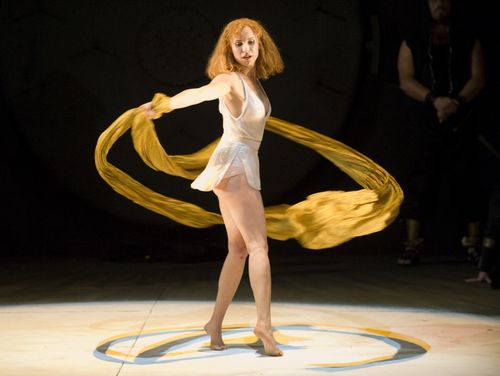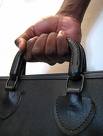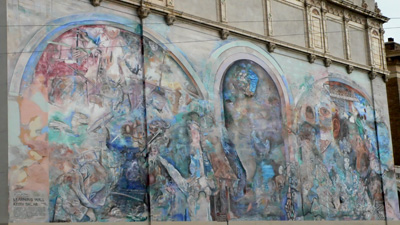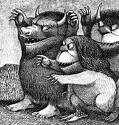 When headliner Nadja Michael (pictured) became “indisposed” last Friday for that evening’s performance of Strauss’ Salome at San Francisco Opera, stand-in soprano Molly Fillmore was flown in from Arizona at the last minute and hustled on stage.
When headliner Nadja Michael (pictured) became “indisposed” last Friday for that evening’s performance of Strauss’ Salome at San Francisco Opera, stand-in soprano Molly Fillmore was flown in from Arizona at the last minute and hustled on stage.
Considering the fact that Fillmore, who is performing the role at Arizona Opera this month, had very little rehearsal time, she did a serviceable job, though the orchestra was too loud and it was quite often difficult to hear the soprano’s voice especially in the higher part of her register.
If only Fillmore hadn’t had to do any dancing.
Salome is not one of those “park and bark” operas, where a singer can get away with standing on stage more or less stock still or walk about a bit. There’s a 20 minute exotic dance routine for the titular character right in the middle of the show. It’s the pivotal moment of the story in fact: The princess wiggles lasciviously for the king and coaxes him into making her a rash promise that will cost him his kingdom.
I gather from Opera Tattler that Fillmore, though she had had an opportunity to rehearse the role with San Francisco Opera early in October, had not had much of a chance to learn the choreography. The dance, which in this production draws inspiration from early 20th century choreographers like Isadora Duncan, Ruth St Denis and Martha Graham, has some tricky moments in it, particularly involving the skillful manipulation of a variety of gauzy veils.
Fillmore moved awkwardly throughout. It was rather painful to watch her go through the motions. I was terrified that she was going to get herself tangled up in a veil or, worse, still, trip over her own feet. Plus, she lacked grace and lyricism, making the dance more clumsy than sexy. The twenty minutes went by agonizingly slowly.
I suppose it’s mean-spirited of me to fault an underrehearsed performer who stepped up to the plate at such short notice. And it’s not as if Michael had been earning raves herself in the role. Mark Swed of the Los Angeles Times reviewed the production on October 22 and had trouble with Michael’s intonation, though he at least found her slightly more convincing in the part from a physical perspective.
But I won’t forget Fillmore’s Dance of the Seven Whales in a hurry, which isn’t necessarily a good thing.

 Andrew Taylor’s latest
Andrew Taylor’s latest  Even the most lighthearted and confident stars of the opera stage suffer from moments of unconscious stress. The bubbly American mezzo-soprano Susan Graham is currently in rehearsals with the
Even the most lighthearted and confident stars of the opera stage suffer from moments of unconscious stress. The bubbly American mezzo-soprano Susan Graham is currently in rehearsals with the  The San Francisco Public Schools commission is running a marketing campaign right now. The slogan on posters dotted in bus shelters and elsewhere around town is “The City is Our Classroom.” “That’s all well and good,” I thought as I walked passed a poster on a walk around the neighborhood this morning. “But that doesn’t make up for the fact that classrooms, in the conventional use of the word, aren’t necessarily doing their job anymore in this city.” I was thinking in particular of my recent visit to San Francisco’s rundown School of the Arts (SOTA) (see my
The San Francisco Public Schools commission is running a marketing campaign right now. The slogan on posters dotted in bus shelters and elsewhere around town is “The City is Our Classroom.” “That’s all well and good,” I thought as I walked passed a poster on a walk around the neighborhood this morning. “But that doesn’t make up for the fact that classrooms, in the conventional use of the word, aren’t necessarily doing their job anymore in this city.” I was thinking in particular of my recent visit to San Francisco’s rundown School of the Arts (SOTA) (see my  It’s a wonder that I ever got sent to the US as a technology correspondent for a major British newspaper back in 2000, really. My lack of prowess at — and genuine interest in — figuring out the nuts and bolts of everyday applications I use is not something of which I’m proud. But there’s only so many things I can pay attention to on any given day, and worrying about which format I transfer audio files to and from my laptop sadly isn’t one of them.
It’s a wonder that I ever got sent to the US as a technology correspondent for a major British newspaper back in 2000, really. My lack of prowess at — and genuine interest in — figuring out the nuts and bolts of everyday applications I use is not something of which I’m proud. But there’s only so many things I can pay attention to on any given day, and worrying about which format I transfer audio files to and from my laptop sadly isn’t one of them. Articles about how the recession is affecting the arts in San Francisco are commonplace these days. Janos Gereben’s October 25
Articles about how the recession is affecting the arts in San Francisco are commonplace these days. Janos Gereben’s October 25  In the middle of the San Francisco
In the middle of the San Francisco  It’s a curious and not always desirable thing when an artist becomes so closely identified with one canonical work that the rest of their work gets ignored.
It’s a curious and not always desirable thing when an artist becomes so closely identified with one canonical work that the rest of their work gets ignored. Ukulele virtuoso Jake Shimabukuro has made a name for himself for pushing the ukulele to its aesthetic limits. But is it necessary to push the instrument so far that we don’t get to hear the uke at all? Shimabukuro’s
Ukulele virtuoso Jake Shimabukuro has made a name for himself for pushing the ukulele to its aesthetic limits. But is it necessary to push the instrument so far that we don’t get to hear the uke at all? Shimabukuro’s  A question to all you culture writers and artists out there: How do you cope with the guilt of not getting to experience even a fraction of your city’s arts offerings? It’s an embarrassment of riches.
A question to all you culture writers and artists out there: How do you cope with the guilt of not getting to experience even a fraction of your city’s arts offerings? It’s an embarrassment of riches. Sick of boring standing ovations and polite clapping? Wish audiences would show their feelings about a performance in a more visceral way? The San Francisco-based theatre company
Sick of boring standing ovations and polite clapping? Wish audiences would show their feelings about a performance in a more visceral way? The San Francisco-based theatre company  As every understudy knows, it’s very difficult stepping into a star’s shoes when you know everyone has paid to see someone else in the role — not you.
As every understudy knows, it’s very difficult stepping into a star’s shoes when you know everyone has paid to see someone else in the role — not you.